The duo let us wander their world of creative expression and emergence.
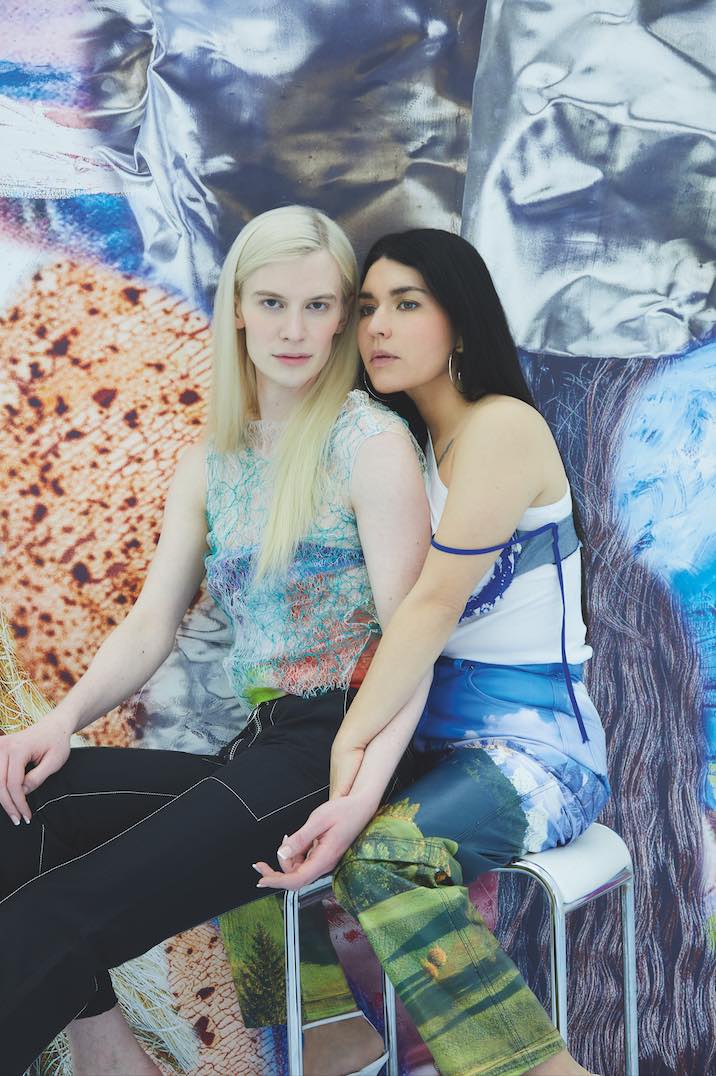
Initiating us into their dance of storytelling are Lyra Pramuk and Donna Huanca; two world-builders, cutting-edge multidisciplinary artists and regular collaborators, but most of all, kindred spirits. The tools of creation employed by each may differ—Pramuk is a vocalist and electronic musician, while Huanca works primarily with paint, sculpture, installation and performance—yet both sustain emotion, sensuality and devotion as the focal points of their artistry. In her practice, Huanca paints models in psychedelic hues and encourages them to engage in non-choreographed, almost meditative performances in site-specific rooms designed by the artist herself. At first glance, Pramuk works within a medium distanced from Huanca’s visually-soaked realm: on her much-anticipated debut album, Fountain, Pramuk has fabricated a seven-track world entirely out of her own voice. In essence, however, the two artists both utilize the body as a boundless spring and urge us to unlock its potential by embracing processes of continual transformation. Glamcult meets the artists in Huanca’s studio in Berlin, but this time around, we retreat to a green corner of the room while the two enter their own magical dance of words and ideas.
Huanca: I’ve seen you blossom like a flower since we first met. In one of our early meetings, we were talking about the future and all the things you wanted to do. Today, you’ve made some hard decisions, you’ve taken action to put your record out, and that’s such a vulnerable thing to do; to not know how people are going to react, since this album doesn’t really have a beat, it’s not within the scene, it feels a-historic in a way. Similarly to my own work, in which I also don’t look at history. Things just happen.
Pramuk: Someone asked me the other day, “Where do you see yourself in history?” All I could think of as a reply was that I can just trace my influences. I’ve been sitting on my computer making weird stuff for like six years, and I don’t see myself as part of history. I do what I need to be doing. Just like life—it exists because it needs to. There’s a certain autonomy to it; something with its own agency.
Huanca: And that’s OK; it’s enough. We’re tricked into believing that we have to give it a categorization or a reference. But you have to also think about where those references are coming from. They’re usually Euro-centric and come from a very specific place by people who won and wrote history, and thus destroyed other histories. Fuck all of that! I like making my own language.
Pramuk: Your work has become much more visible, and you work with institutions so much more often now. How do you feel about your background in music and DIY punk culture? How do you carry that ethos?
Huanca: Well, I always think about the relationship with my models as a new form of band. I used to be in bands and I had such intimate relationships, where you had to really be on the same page to make a good composition or improvisation. All of those experiences have helped me be flexible to other people’s sensitivities. I really want to hear other people out, I want to see what they’re thinking, but also allow them to be free.
Pramuk: Your cast of collaborators, models and everyone you work with to bring the show to life, it does feel like a collective. I mean, we’ve been friends for a long time, but I remember when you first asked me to come into your work, the overriding sense was of joining a community.
Huanca: I don’t take full responsibility for my shows, because it’s not me doing it; it’s everybody doing it. The audience and the performer are experiencing an alignment in real-time. So we’re all contributing to this larger alignment at that moment. It’s very brave, it requires a lot of sensitivity, and it’s triggering, especially if you’re performing. That’s how I’ve gotten to know you, too. For each of my shows, we’re so close as I paint your body. I don’t really know what you will look like in the end, but I’m going by the conversations that we have and the energy that you bring. It’s what tells me what colour to paint you and how to do your hair. Every little aspect is just energy exchange.
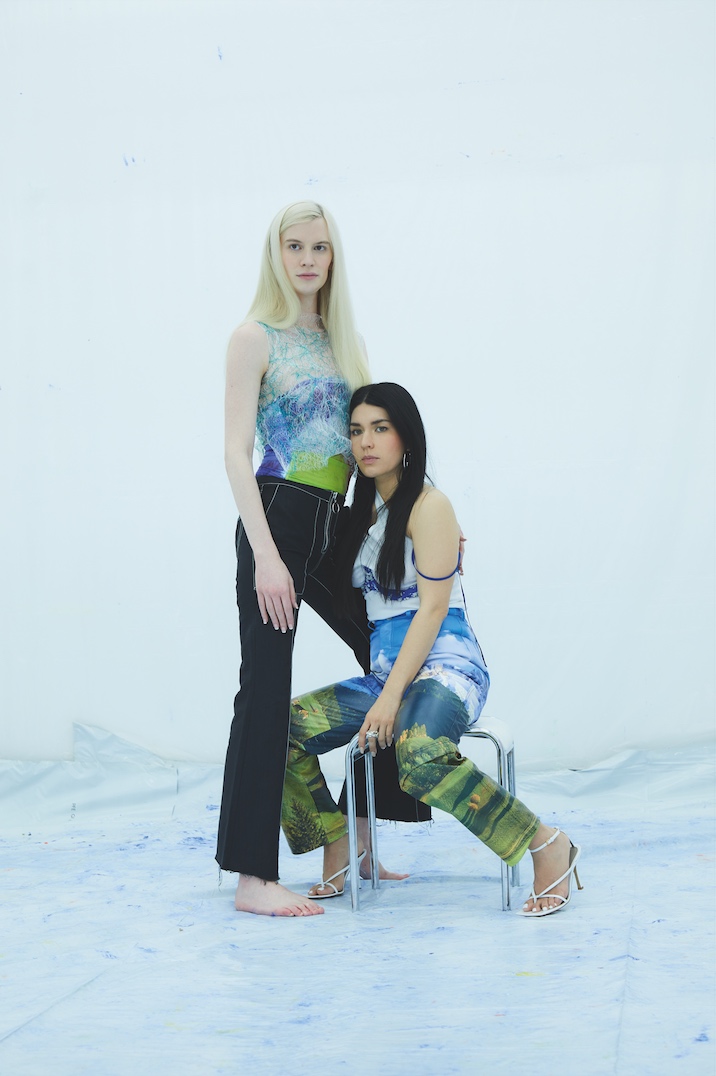
Pramuk: This ties in with the inherent trust-building of the work we do. I think this has definitely affected how I think of economies I’m a part of too. In that context, being part of your performance environment is such a spiritual thing that I always sort of trip out. Just thinking about looking out at the audience that’s coming to consume an art product but discovers a disruption of that consumerism… The performance, it feels like, is transcending anything within capitalism. Do you get what I’m trying to say?
Huanca: Absolutely, because you’re not for sale. You are autonomous, ephemeral and temporarily present. All of my work begins with the body and that intimate moment we have when I’m painting you. That trust you give me as a model gives me the courage to make marks. I also don’t really like the word performance, but I guess that’s what it’s easily described as.
Pramuk: Yeah, words are clumsy.
Huanca: But it’s important to distinguish that you can’t intellectualize the moment a work is being performed. Art is elitist and people try to bring all these tropes to the work. Yet you can’t intellectualize something that’s still going on, something that’s being created in front of you. It all goes back to the idea of thinking about something versus actually doing it, and those are very different things.
Pramuk: You talk about being able to define something in intellectual terms, but also in market terms, which is something else I think about a lot. In the music industry, and when you’re a singer, there are these expectations and codes of being a pop musician. I restarted my music project at the time I began transitioning, which was about the time when we met and started collaborating. Being a part of your work is an experience in itself, and you have to pay attention whilst that experience is happening. This led me to think about my live performances in terms of escaping intellectual or market value; my concerts as a spiritual or religious experience.
Huanca: Right! That’s what I find so beautiful about your performances, and you can see it; especially knowing you, and knowing how smart you are and how much you devote to your work. But actually, when I experience your show, it’s beyond what you know and what I know. It’s tapping into something that’s very subconscious, universal and human. I remember when you first let me listen to the record, I started crying and I’m not even that emo! But I felt the pain and the way that you’ve been working on it.
Pramuk: Yes, I played you one of the opening tracks in the car, and when the first vocal came up you saw this image of a girl sitting and combing her hair, sort of defeated. Or like, almost in the action of brushing her hair, so it feels like a defeat but she’s still doing something, organizing something, trying to get herself together. A kind of impetus towards healing and always trying to make yourself better through working on yourself. One of the images from your work that hits me emotionally the most is a piece of clear vinyl that you’d scorched with fire so that there are burn marks. It was a body piece on one of the model’s stomach. That hit me so much, it’s such a visceral feeling of your gut burning. I think we’re all sort of carrying wounds like that, but to display the wound in your own work, it felt very healing to me. Make the wound visible so you can start to heal.
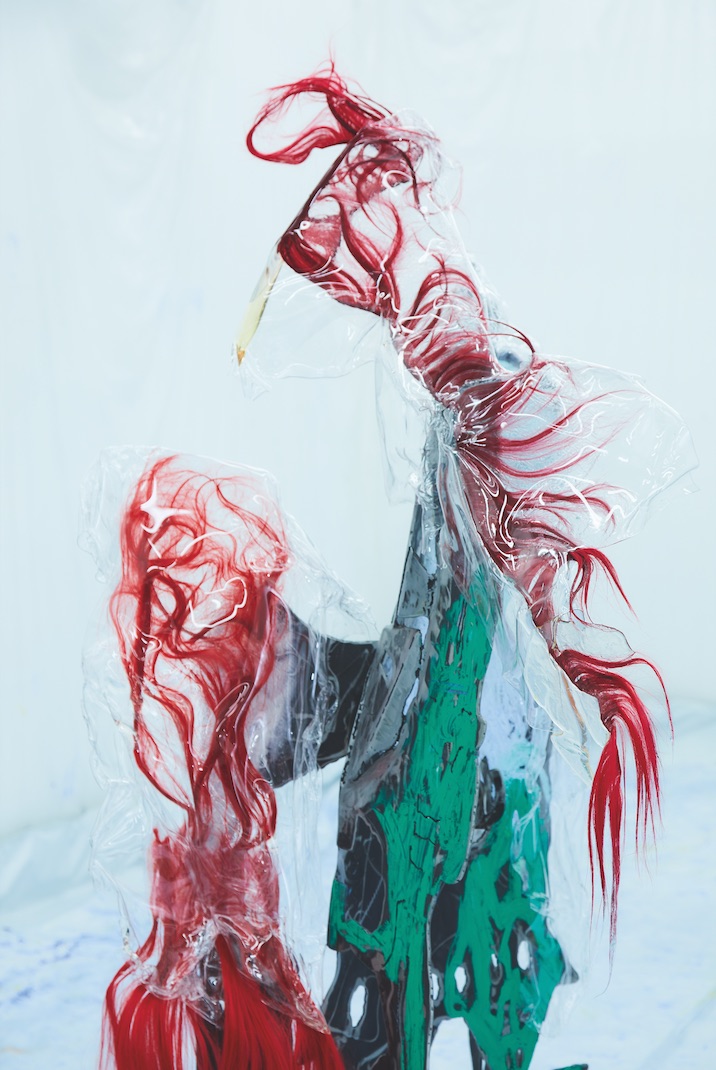
Huanca: A lot of the mark-making I do with the body is not supposed to be beautiful, although it somehow is in the end. I think the totality of it is something I consider beautiful. There’s a lot of pain in beauty, so when I hear your album, I just feel the pain and the struggle of there just being so many different voices emerging at the same time. Just like a mermaid, or this deep-seated creature that is alien but is trying to find her particle form. We capture this emergence of beauty and all the nasty things that come with it too.
Pramuk: And that’s the most vulnerable and powerful thing. To just be real about that pain, to say it and not run away from it. It’s so strengthening to name what has hurt us. I was trying to do that in some way when I was working on the music, but we started talking about the album artwork before most of the songs were even finished. At the time, I had been working on a sort of water journey through the pieces, writing down and drawing every form of water I could possibly find. Water is so transformational and connected to so many cultures and rituals: baptism, bathing, cleaning or purging. Graphic designer Gergö Kovács, who I also worked with on the artwork, they added a butterfly to the design. Did you know that when the caterpillar goes to make a cocoon, and once it’s inside the cocoon, the first thing that happens before it turns into a butterfly is its whole body turns into liquid?
Huanca: Whaaaat?
Pramuk: The cells are called “imaginal cells”.
Huanca: Imaginal?
Pramuk: Like imagination, the cells of the liquid.
Huanca: Wow.
Pramuk: Isn’t that beautiful?
Huanca: Yes, because to transform we have to dissolve and it’s ugly. Allowing yourself to dissolve, I think that’s where people get stuck, because we’re taught to identify as one thing or another. That’s why I think it’s important to create and let go, and also to be OK with making ugly things. I know that you were going through a lot when you were working with your voice, for example. I remember you expressing the uncomfortable aspects of using your lower voice versus your higher voice, and how you were training to navigate this. Using the things that you were not comfortable with for the purpose within a bigger scheme of things.
Pramuk: Oh my god, thank you for saying that! For three years, I was just hoping to find a way to make a whole record where my voice would sound feminine. It was a really big change and growth in myself to just say, “I have to accept my whole voice for what it is. I’m going to accept my whole voice for what it is. And I’m going to accept where my body has been and the journey I have been on.” That’s something you really embody. I think you renew yourself continuously.
Huanca: Yeah, and it’s really hard, but it’s also our duty. It’s not like we’ll reach the perfect form eventually. There’s no such thing. Still, meditation has helped me to kind of stop and become cells; to listen to myself and let all the voices dissolve.
Pramuk: I just want to go back for a second and say something about singing in the low voice. When you’re a transfeminine person, hormones never make your voice higher. Whereas for transmasculine people who take hormones, the voice does become lower. In my case as a transfeminine person, the voice never became higher, but I can change it since it’s a muscle. This made me think, what is a natural voice for a transgender woman? What makes a voice natural? Is it something that exists or can be defined?
Huanca: Well, I think that’s up to you, because you can train yourself to have the voice you want. Or you can work towards it. I don’t even know what nature is at this point, but for me you embody so much more than a feminine voice or a masculine voice. You are all of that and then some more. I think that this record is so beautiful, because you embrace all of those sides and the spectrum of the voices that you have, seeing how important the low voice is to make certain dynamics in the songs.
Pramuk: Actually, one of my favourite quotes is by a Pakistani singer, Abida Parveen, who has a huge vocal range. In an interview, someone asked about her being a woman and being a singer, and she said, “I don’t think at all about gender when I’m on stage. I’m a vessel for energy and that’s it.” That’s so cool!
Huanca: Yeah! It’s important to make this work human, because we all have a body and we’re all dissolving and disintegrating. That’s the point.
Pramuk: And there are so many ways of being; it’s just not factual. We’ve talked about this before in another context, about nature. You said to me once, something about the green, earthy nature versus—
Huanca: —a completely plastic body.
Pramuk: Or a cybernetic body. What do you think of nature when you think about materials in your work, but also just in general?
Huanca: I think we can’t see nature just as the granola we eat or as biodegradable stuff. That’s not nature. For me, nature is nasty and plastic; all these UV colours and things that look beyond natural. When you think of the underwater world and the creatures that are yet to be discovered, it’s beyond our [stereotypical] image of nature. I’m more about embracing as natural the things that we’ve overproduced, such as plastic. Taking those materials and owning the fact that, yeah, it wasn’t made by nature, but what is nature? The number of products that we make today, and the amount of consumerism that’s out there, that’s natural at this point. We can’t be stuck to what happened before the Industrial Revolution. We have the power to create our own bodies, voices and identities. At this point, whatever we want to do is natural.
Pramuk: There are these two designers, Beatriz Colomina and Mark Wigley, who compiled a book in which they talk about how technology and design originate from within ourselves. We developed technology and then it changed the environment and hence our bodies. One example they use is about the web of a spider, which exists in the body of the spider, which then builds the web outside of itself. Everything that we have made as humans is part of nature, because we are nature.
Huanca: We created it.
Pramuk: Yeah… Mm, do you wanna take a pee break for a sec?
Huanca: Sure, do you wanna pee first?
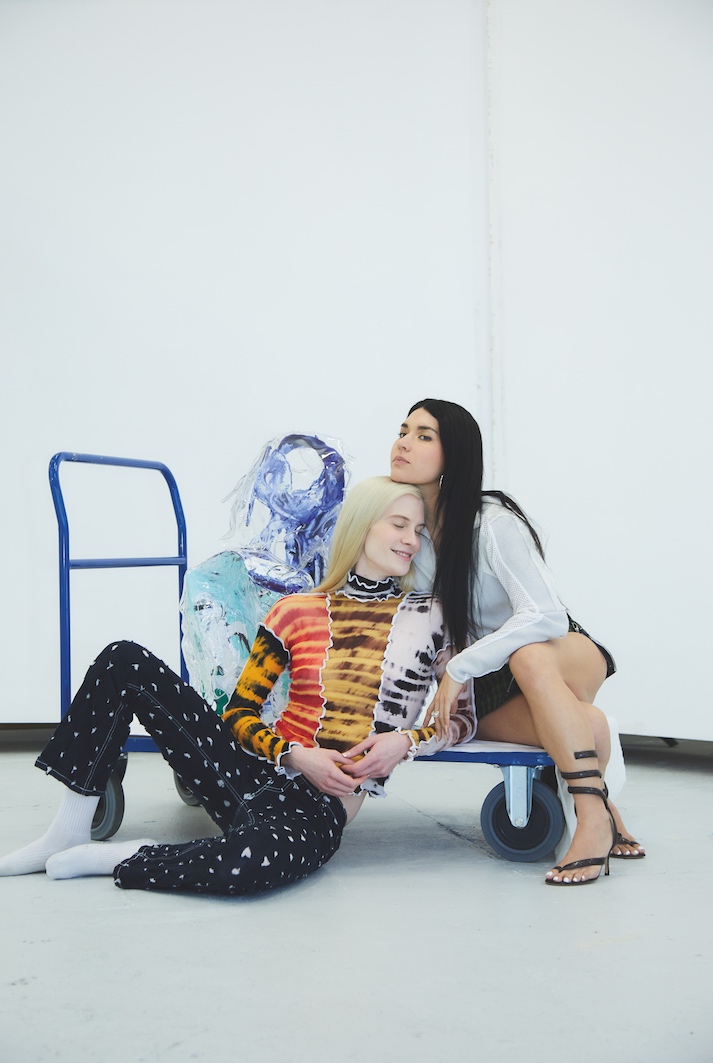
Pramuk: So, when I try to explain your work to other people, I tell them it’s Andean-futuristic, as you once told me. It’s also about decolonizing and picking up scraps of indigenous and Bolivian culture and practices, and sort of reimagining them into the future. What’s so impressive about it is the constant resampling that happens through the multimedia world that you’ve built. I feel the same way when I make songs. I want them to feel like they’re living and breathing, and that they’re not set in stone and can change. In a way, it’s a paradox.
Huanca: Yeah, but we’re creative and we’re always afraid of repeating ourselves. But if you really zoom in deep enough, you can find new content [within your own work]. There’s micro-evolution in every piece I make, and it’s important to honour that.
Pramuk: I think it’s really beautiful to see that as some kind of floral blossoming. If one looks at your exhibitions over the years, a continuous, effectual evolution seeps through; it’s really gorgeous. I think I connect with that a lot, because I sample myself a lot in my work too. When I’m putting a track together, often the samples I have access to are sample packs, or things that have been made by someone else, or samples sold by a company. That’s how a lot of people make music, but because I work with my voice in such an intimate way, it feels weird to juxtapose that with material that came from a source I’m not familiar with. So that’s the reason why I started to make things totally out of my own voice. It felt like it was entirely mine.
Huanca: I feel like also you’re creating a self-sustaining world for yourself, because you rely on yourself to create new content versus looking to what’s outside. We’re also so bombarded with images, and for me it’s important to just go into myself and go into the work I’ve made and sort of sample from that. That sampling process can go on for ever, but it’s also interesting because it does trigger you to invent new things, and that’s what some people don’t see. When you look at what you’ve done, then you’re sort of finding ways to evolve from there while still being authentic to yourself.
Pramuk: A lot of my reluctance to bring in material that may have been made somewhere else, or is for sale, is that I want to feel somehow authentically part of what I make. I know you’re also really sensitive to the context of where your exhibitions take place; the architecture, the lighting of the space, all of these elements you think so carefully about. I think I relate to that too; every concert that I play I think so much about the audience, the size of the room and the stage, the height of the ceilings, the quality and strength of the sound system. I feel like each time I do a performance, it feels like a new thing. Every single time. Even if the set is exactly the same as last time, it feels totally new.
Huanca: Yes, that makes you human! I feel it’s so important to know all of those aspects of the room. For me, one of the first conversations I have with galleries is about the location of the bathrooms in the space and their proximity to the stage. My models need to have somewhere to go! Museums and galleries are so confused. They think, “Oh, people are just going to show up and it’s easy,” and I’m like, “No, you have to feed them, you have to keep them warm, you have to bring security.” Art spaces are not used to this. They’re used to hanging something on the wall, lighting it and being done. In a way, with every performance, we realize how we are changing the system, one show at a time. We’re sort of teaching people how to care for others, how to be sensitive, how to look for different social cues to tell someone to leave. It’s very sensitive.
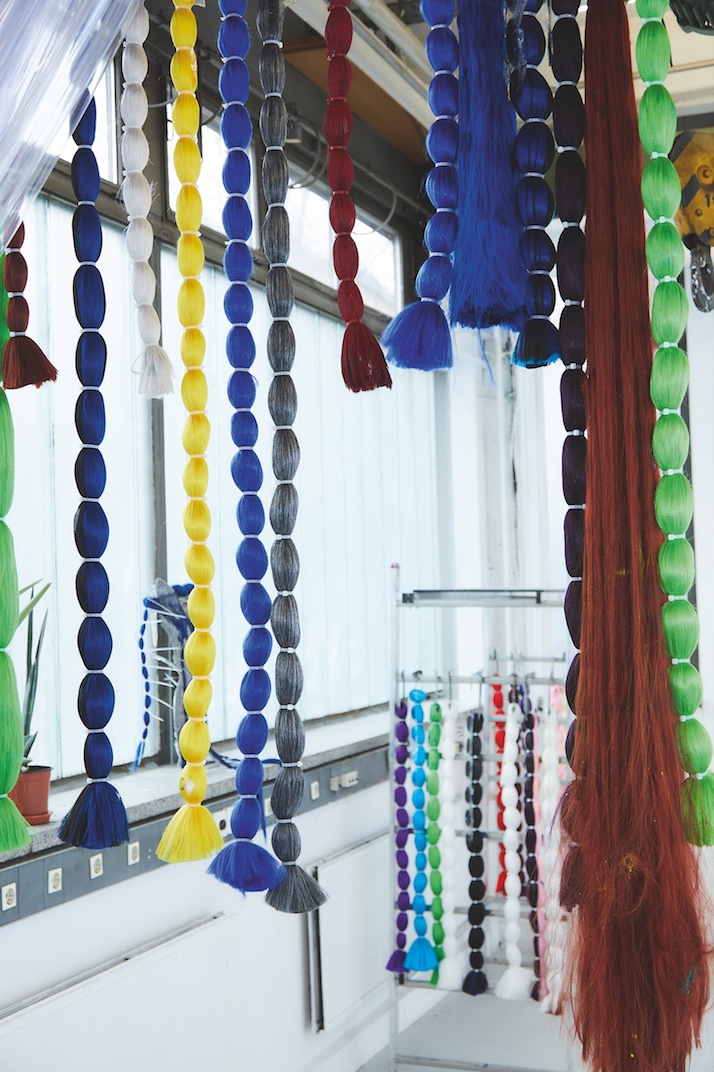
Pramuk: It’s super similar in the electronic music scene too. A lot of what my friends and I do is based on the body, but a lot of these events are made for people who mostly use equipment or a laptop. It’s a different kind of consideration that goes in when it’s your body that’s the vessel. You need time to meditate, enough water, a good meal and time to warm up and stretch before you start. A lot of the places I play are electronic music spaces and there’s this kind of contradiction between awareness of working with bodies and people who are using their bodies.
Huanca: The commitment still needs to be there. The institutions or venues that you play at, they have to be aware of what you require. You’re not just going to show up there with your laptop. I think that’s what makes us all grow together: things can get better one performance at a time.
Pramuk: Yes! We’re into that live experience. That’s the heart and centre of everything that we do. It’s having that one-to-one, giving people an experience where they’re on their own terms and can have an experience with performative work; a living, breathing moment. That’s so special, we need so much more of that in our world today.
Huanca: Yeah, that’s why it’s sort of slowly making its way to the art world. This urgency to feel something and be in a space where people are embodying themselves. It’s not about finishing work; it’s a work in progress. This makes me think of the exchange of privilege to work with you on the album artwork! I mean, I had never really taken a photograph before.
Pramuk: But that was such a blessing. We were here, like, very caffeinated, sprawled out all on the floor of your apartment with my hair out in spirals on the floor. I mean, it was such a trip! Considering that you’d never taken photographs before, the images that we got are amazing.
Huanca: That’s why I think it’s such an exchange. If I wasn’t comfortable with you, I wouldn’t have been able to speak with you and direct you the way I did. If you weren’t comfortable with me, you probably wouldn’t have let someone talk to you like that.
Pramuk: I probably wouldn’t have been topless on your apartment floor!
Huanca: For me, that’s such a privilege; to be able to see you grow and go into your own. It’s going to go on, this is just a pause. Whenever we talk, or whenever we’re able to create something together, I learn so much. For me, this is how I communicate now, this is how I have friendships and growth, through collaborations. The image we made for your album cover makes so much sense now.
Pramuk: It does!
Huanca: It’s like you’re emerging…
Pramuk: We are emerging.
Photography by Joseph Kadow
Notifications